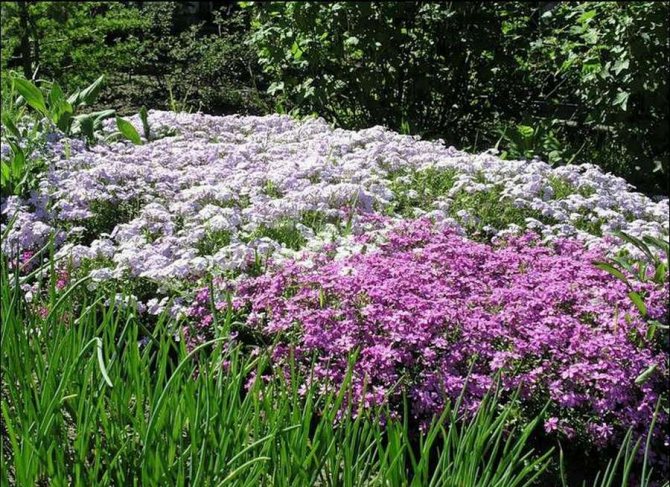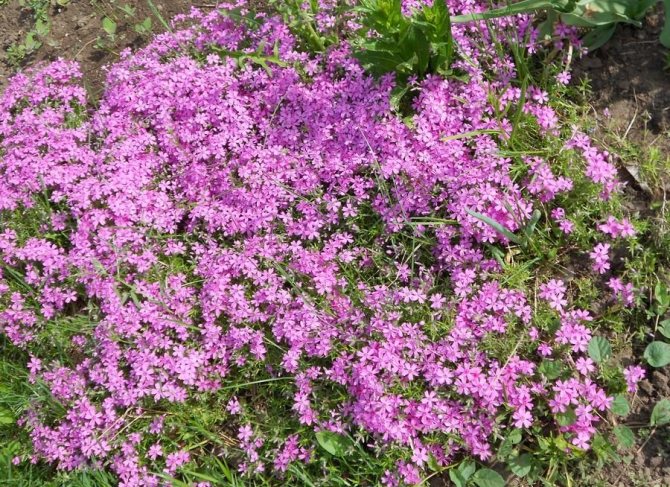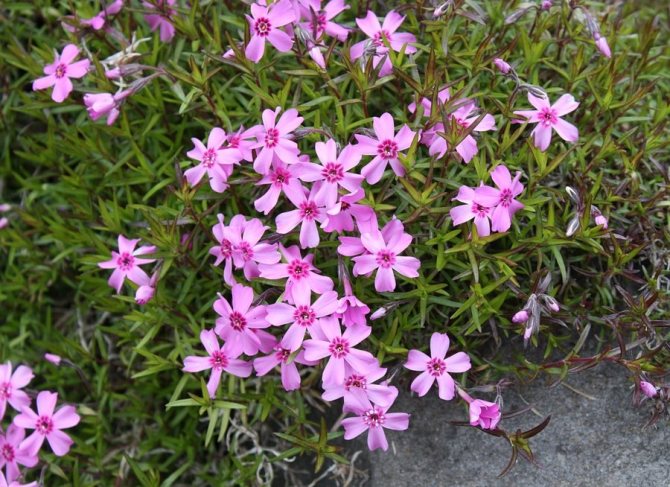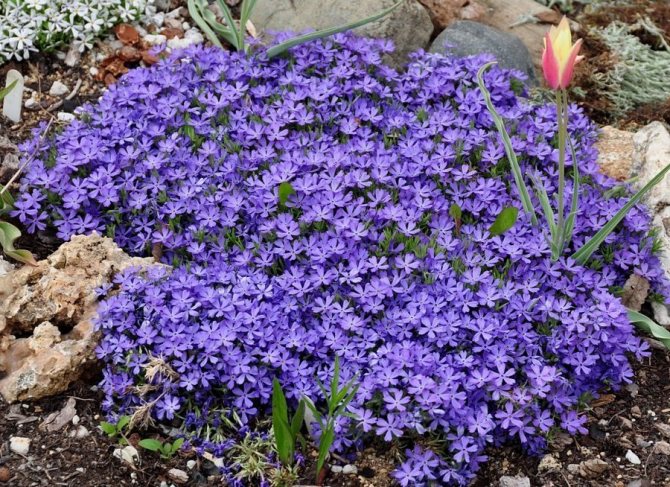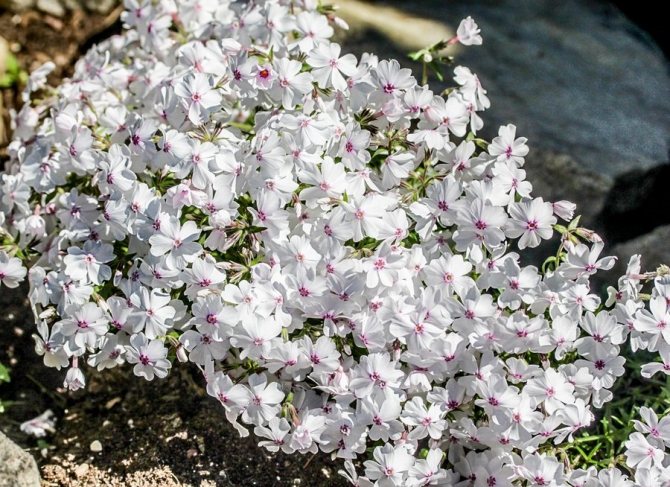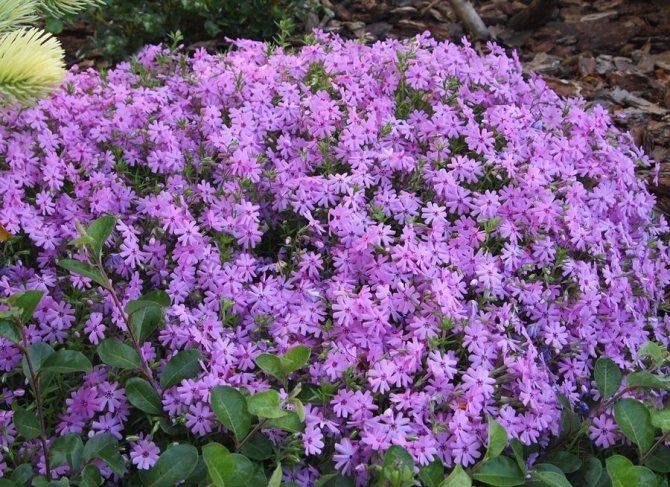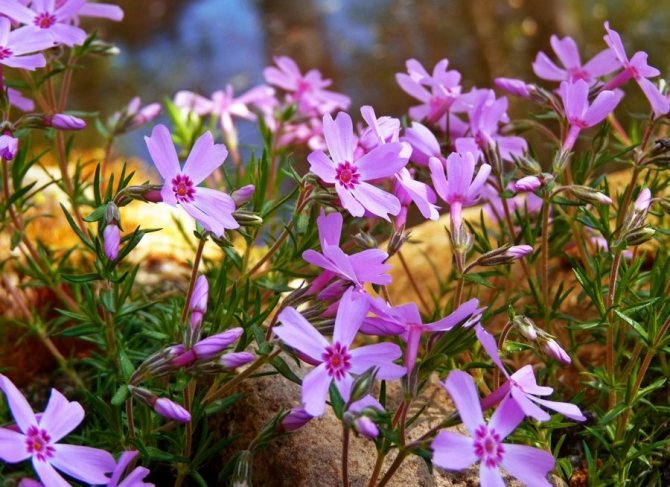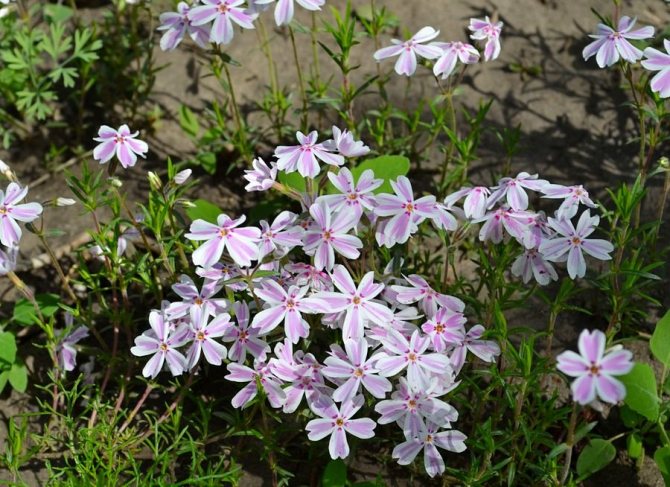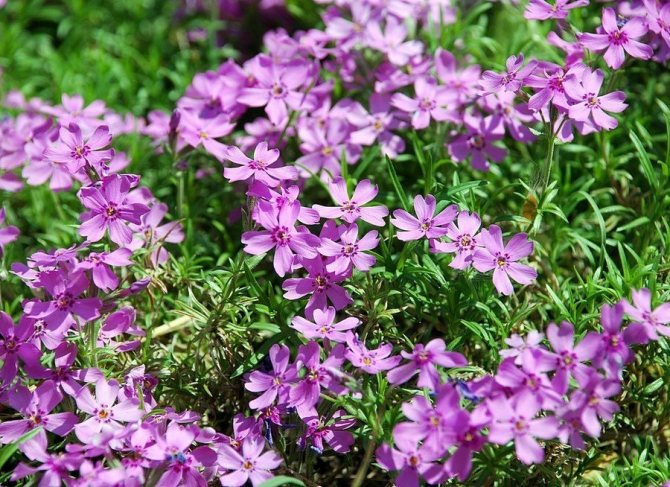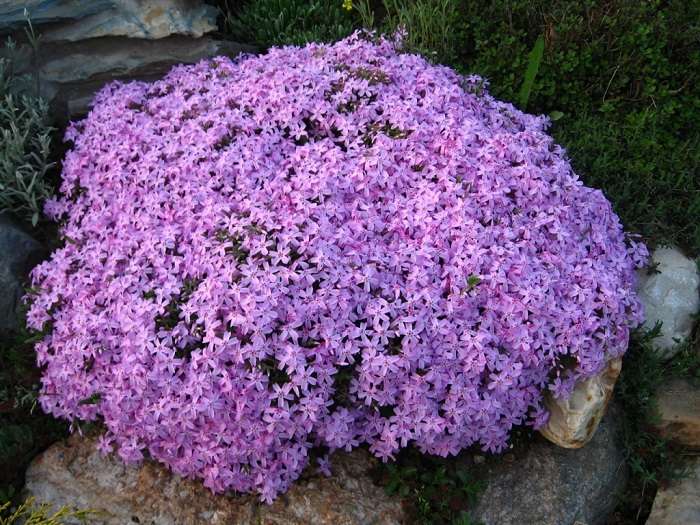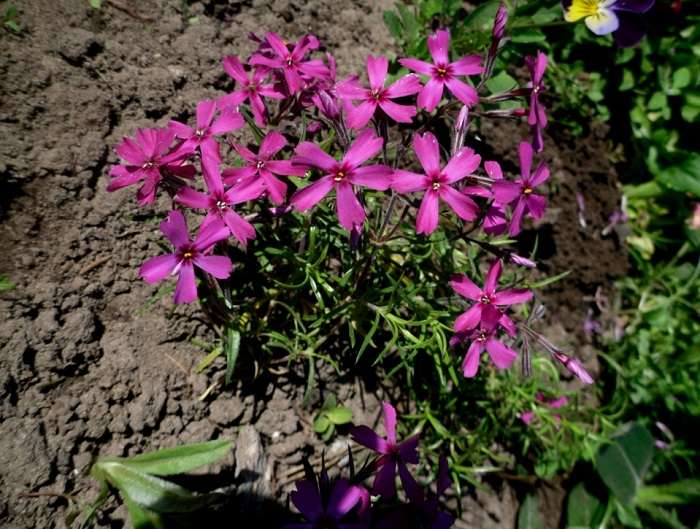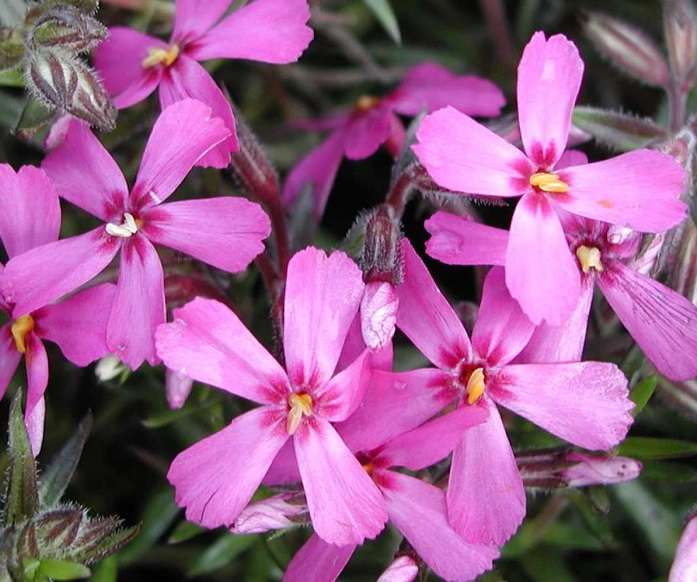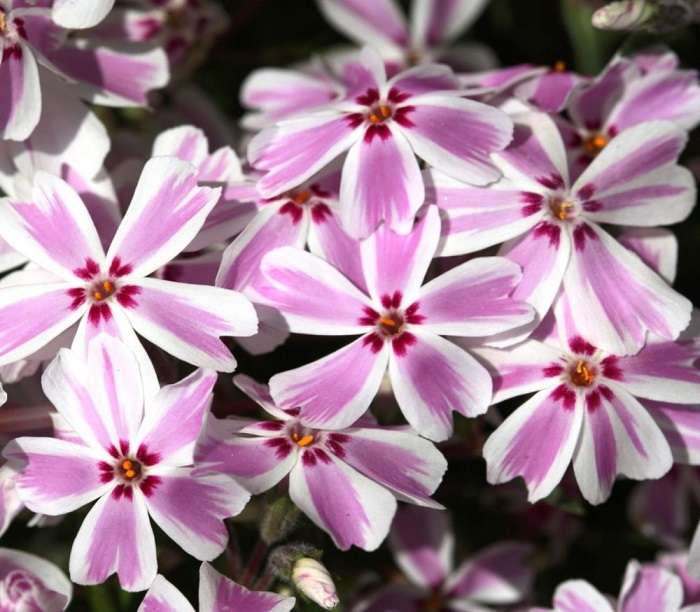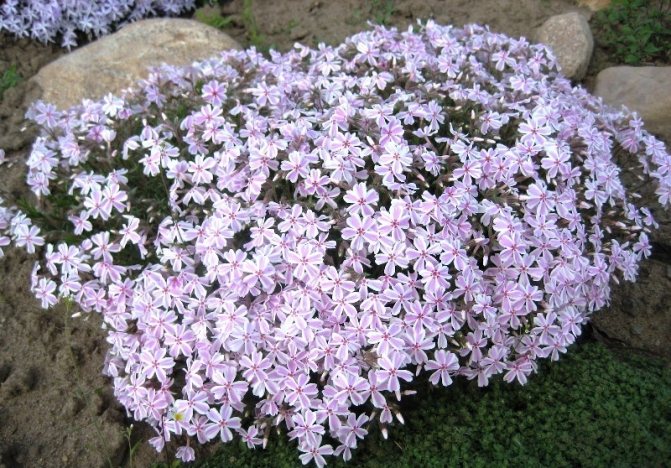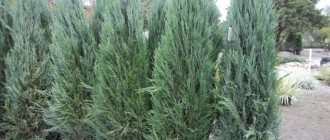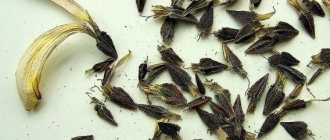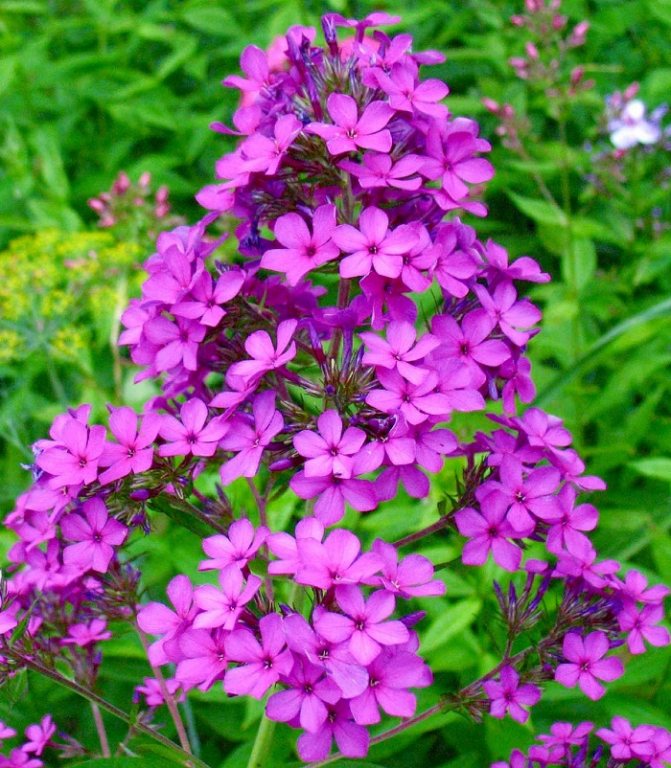
To obtain a solid carpet, subulate phlox are planted in areas and flower beds. Sparkling stars delight the views of others from May to August, and some varieties are able to bloom until late autumn. They are unpretentious to care for, grow in the driest places. They love the sun and do not tolerate strong moisture. Many budding growers make the same mistake when planting them in wet areas. Subulate phlox - correct planting and care, affects the duration of flowering.
Description
This frost-resistant plant is native to North America and does not require special care. The greatest advantage of this variety is the variety of variegated forms. Therefore, the subulate phlox is considered the most popular plant in landscape design.
Its height is 17-20 cm. The creeping stems of the plant densely envelop the entire surface of the earth with dark green greenery. Each stem has numerous narrow, sharp leaves. A peduncle is located at the top of the shoots. The flowers are medium in size, 2-4 cm in diameter, depending on the variety. Their color is very diverse - pink, snow-white, purple. Phlox subulate does not bloom for long - for three weeks, from mid-May to the end of the first decade of June. With good care, re-flowering can be achieved, which begins at the end of August and ends in mid-September.
The most common hybrid varieties of styloid phlox are Maischnee, White Delight, Apple Blossom, Vivid ', Fairy, etc. They are readily used in landscape design for colorful decoration of mixborders, retaining walls and gardens. These plants do not require special care and attention.
The subulate phlox Bavaria is a relatively new species with magnificent snow-white flowers decorated with lilac rays in the center. It is a rare low-creeping perennial that thinns its light delicate aroma during the flowering period.
Hybrid Bavaria is valued for its decorative, abundant flowering, frost resistance. Caring for this variety is pretty simple.
Loading ...
Subulate phlox is grown in sunny areas where there is no stagnant water. Phlox grow and bloom poorly on wet soil. The best predecessor of this variety is considered to be calendula, lawn grasses, tagetes, as well as other perennial plants that cannot tolerate roundworms and nematodes.
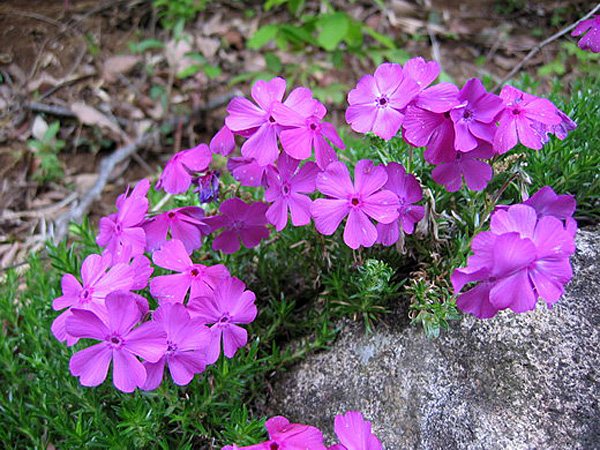

Planting phlox subulate
Phlox are one of the most convenient plants for flower growers. They are unpretentious, take root well, do not require special care. But certain rules for planting and caring for a plant must be followed in order to achieve its lush flowering.
Seat selection
For all its undemandingness, the styloid phlox has its own preferences for the landing site. The plant thrives best in sunny places with well-drained soil. If the plant is planted in areas with heavy soil, it must be diluted with sand. In partial shade, you can also achieve good flowering, but care must be taken that the soil is not excessively wet: phlox suffers in wetlands, in areas with high humidity. Poor or stony soil will not cause problems for the plant, phlox will easily master it and cover it with a beautiful carpet. The plant develops better on neutral soils.
Landing
Before planting, a landing pit is prepared for the shrub.The order of its filling: drainage (expanded clay, pebbles), a mixture of soil with humus and a small amount of ash. Seedlings, cuttings or parts of a bush are dipped in Kornevin's solution, after which they are planted at a distance of 30 cm from each other, so that each bush has room for stems that will soon appear.
When planting in early spring, when the soil is still wet, additional watering of the planted plants is not required. If the cuttings are planted later, when the soil has already become dry, it is moistened around the planted cuttings. In this case, you need to be careful not to overfill the cutting. The planted cuttings are covered with a non-woven cloth and left for several days (up to 1 week) for the cuttings to take root.
Varieties
"Aurora" (‘Aurora‘) - the flower is almost white, has a pale pink tint, in the flower garden it looks like white. The shape of the flower is stellate. Diameter 2.4 cm. Forms carpets with a height of 12 cm - real white snowdrifts.
"Amazin Grace" - ve (‘Amazing grace‘) -The flower is white with a bright carmine-purple eye. Diameter 1.8 cm. Forms carpets with a height of 12 cm.
“G. F. Wilson "G. F. Wilson‘) Is a light lavender blue, star-shaped flower. Diameter 1.8 cm. Forms carpets up to 20 cm high, is considered one of the strongest varieties. Branches profusely, reproduces well. Widespread in green building.
"Thumbelina" (‘Dujmovotcshka‘) Is a deep cold pink flower with a dark carmine eye. Diameter 1.6 cm. Forms carpets 10-15 cm high. The leaf is dark green. Growing rapidly.
Coral Ai (‘Coral eye‘) - a light pink flower with a carmine eye, star-shaped. Diameter 2.0 cm. Forms carpets with a height of 12 cm. It grows and reproduces well.
Candy Stripes (‘Candy stripes‘) -The flower is white with a wide pink stripe in the center of the petal along its entire length. Diameter 1.9 cm. Forms carpets 10 cm high. Abundant, lush, long flowering. It enjoys special love and popularity due to its unusual original memorable color. It resembles the “Mishenka” variety of paniculata phlox.
"Myshneye" (‘Maischnee‘) - a snow-white flower, beautiful wheel-shaped. Diameter 1.5 cm. Forms carpets with a height of 8-10 cm. One of the most beautiful and widespread white varieties. Against the background of bright plants, it truly dazzles with its whiteness.
Nettleton Variegata (‘Netteleto variegata‘) - the flower is pink. Diameter 1.7 cm. Forms carpets 10 cm high. Valued as variegated variety. Leaves are dark green with a whitish-pink border; the border turns bright pink in the sun. It can be used as an ornamental plant to decorate any flower arrangements.
Tellaria (‘Tellaria‘) - lilac flowers with a carmine eye, star-shaped. Diameter 2.3 cm. Forms carpets 12 cm high. Differs in very long flowering.
"Temiskaming" (‘Temiscaming‘) - the flower is very bright, dark crimson-purple. Diameter 2.0 cm. Forms carpets with a height of 15 cm. Differs in strong growth, active branching of stems and dense turf. Beautiful dark with red leaves. Propagates well by cuttings. Since 1956, one of the most purchased varieties.
Also found on sale:
- 'Appel Blossom' - pink flowers;
- ‘Atropurpurea’ is undersized, with dark carmine pink flowers with a dark eye.
- ‘Avalanche’ —white;
- ‘Daisy Hill’ — pink flowers;
- ‘Leuchtstern’ - pinkish-reddish flowers. The pillows are very thick.
- ‘Moerheimii’ - pink flowers with red eyes;
- ‘Ronsdorfer Schone’ - salmon pink flowers;
- ‘Samson’ - bright pink flowers;
- ‘Thomasini’ - purple-blue flowers;
- ‘Vivid’ - flowers are dense pink, round. The turf is dense and grows well. One of the best varieties.
- 'White Delight' - White flowers, grow well, one of the best varieties.


The use of phlox for landscape design
In the event that you want to decorate the exterior design of your own home with phlox, the plant is used in the following options:
- Lawn... Ideal for large areas.
- Alpine slides... Here phloxes can be placed on the very top of the structure, as well as smooth out all the irregularities.
- With the help of phlox, you can create curbs along the gazebos or paths.
- When you are present mixed flower beds, then it is better to plant phloxes in the foreground.
- Very often, many people post track using stones or slabs. In between, you can plant these plants.
- Plants are very often used on balconies or near gates.
In order to correctly determine the purpose of phloxes, you should study this issue in more detail. From the photographs, you can understand not only the necessary method for disembarkation, but also see some detailed recommendations that will be useful to you in the future.
You will be interested: Austin roses in landscape design: the benefits of the variety, care and watering


Fertilizers and feeding phlox
During the period of active growth, subulate phloxes are given a mineral supplement, which includes nitrogen and phosphorus. To accelerate the development and survival of the subulate phlox flowers, a little ash, substrate and humus are poured into the planting hole. But be careful with fertilizers: phlox grow quickly from a large amount, but their flowering will be modest.
Wood ash is the optimal fertilizer for this phlox species. It is used for indoor and outdoor feeding, preparing fertilizer on its own. For cooking, you will need 350 g of ash and 2 liters of boiling water, in which the ash is cooked for 10 minutes. After the mixture has cooled, it is filtered, another 10 liters of pure water is added and used as directed.
Care
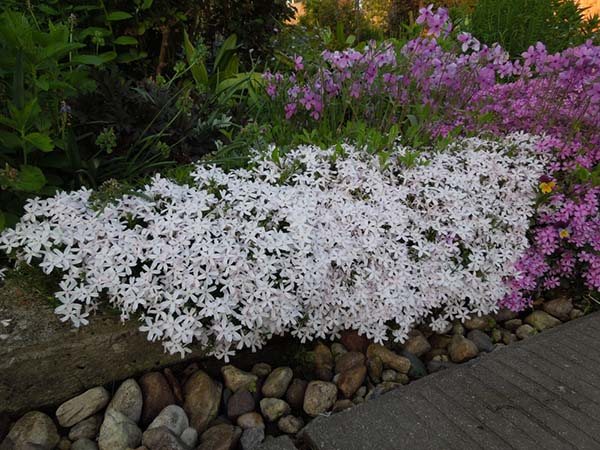

Phlox subulate grade "Aurora"
The cultivation and care of subulate phlox includes traditional procedures.
Watering
Moderation when watering is one of the conditions for the successful development of a plant. The beautiful shrub is hardy and can withstand short dry periods. Excessive moisture becomes more problematic for the plant, it can lead to decay of the roots and plant diseases. Therefore, the flowers are watered sparingly, after the topsoil dries up. In a dry summer, watering is carried out once every 2-3 days, the rest of the time it is enough to water the subulate phlox once a week.
Weeding
Growing and caring for a decorative dwarf shrub is not complete without systematic weeding. The soil is cleared of weeds before planting, trying to remove the roots in it from the soil mixture. In the future, the plant is weeded regularly.
Top dressing
During the season, you need to carry out several dressings of phlox. This will prolong flowering, make the plant strong and hardy. Most often, gardeners feed the plant with liquid manure, a small amount (25 g) is diluted in 10 liters of water. You can also use mineral fertilizers.
| FEEDING | TIME | WHAT TO FEED |
| First feeding | before flowering (end of April) | diluted manure or fertilizers based on nitrogen and potassium. |
| Second feeding | June | manure solution with added superphosphate |
| Third feeding | end of july | ash solution (ash (300 g), hot water (2 l) is boiled for 7-10 minutes. After the solution has completely cooled down, water the plants with it). Instead of an ash solution, you can use a phosphorus-potassium supplement. |
Pruning
In the spring, you can prune the plant. This will form a beautiful bush. When pruning at other times (summer, autumn), the buds on the shoots are removed, which leads to problems next year. Timely removal of corollas, which have faded and dried up, provides a second flowering (August - September).
Video "Phlox subulate - planting, care and reproduction"
Reproduction
Vegetatively and by seed. The easiest and most common way is to divide the bush. Transplanting and dividing is best done in early spring. The distance between the plants is chosen taking into account the height of the bush and the duration of being in one place, from 35-45 to 50-60 cm.
In production conditions, phlox propagation by stem cuttings is very effective. Cuttings are cut before budding begins.Cuttings must have at least two nodes. When propagated by stem cuttings "with a heel" they are taken in the spring, at the beginning of the regrowth of shoots. Shoots 4-6 cm long are broken off from the mother plant, separating them directly from the rhizome. These cuttings take root very quickly and produce normally developed plants by autumn.
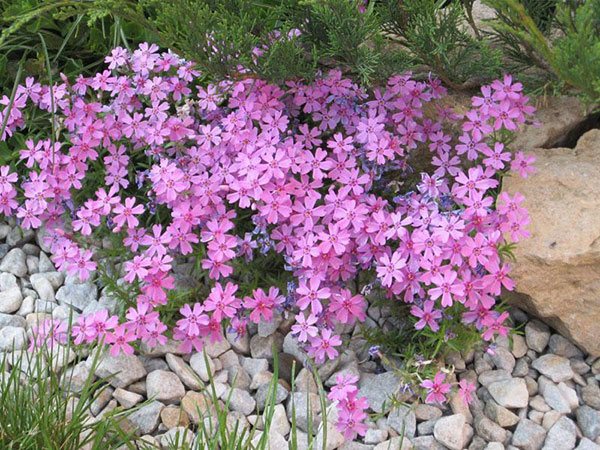

The cuttings are planted in boxes or on ridges with fertile soil, with a layer of washed river sand, shaded and watered with warm water 2-3 times daily. For propagation of valuable varieties, presented in limited quantities, leaf cuttings are used. Leaves are cut with part of the stem before budding. The lower part of the leaf with the heel is dipped obliquely into the wet sand of the nursery or exploration box, covered with glass and periodically sprayed. Rooted cuttings give small plants, which, when planted in the spring in the ground, give full-fledged plants by autumn.
Low-growing, creeping species are mainly propagated by dividing the bush and stem cuttings. Seed propagation is little practiced. Seeds are sown in the fall in open ground or for seedlings in February. In early spring, friendly shoots appear, which, with the development of the first or second pair of true leaves, dive. It is important not to allow the soil to dry out. In the spring of next year, the plants are planted in a permanent place.
Landing in open ground
Before you plant the plant on the site, you need to choose a place that should be sunny and dry. Phlox subulate well tolerate partial shade, but this can affect the abundance of flowering. The soil should be loose and slightly acidic, preferably sandy with the addition of humus (needles and leaves) and peat.
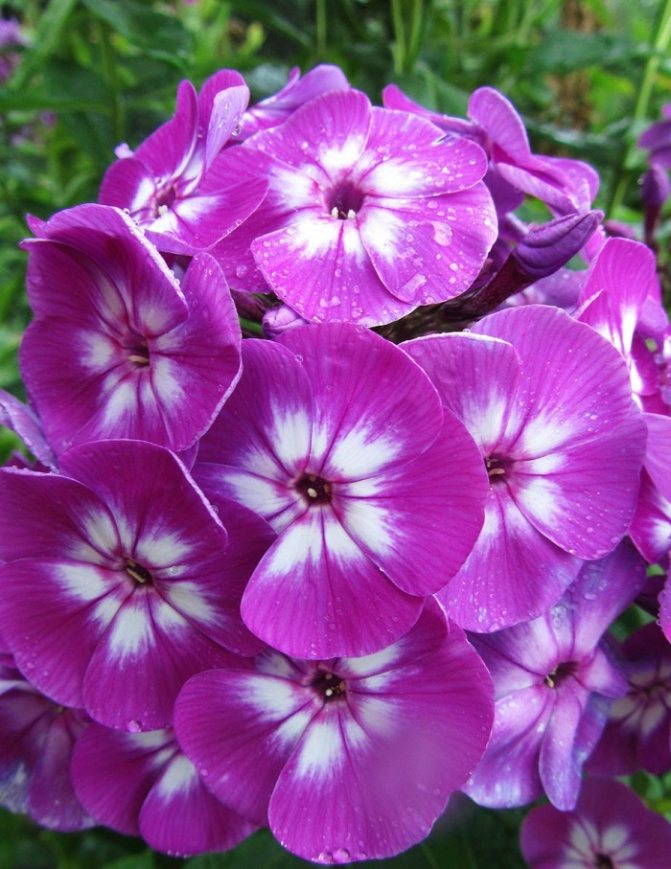

When to plant a flower? Planted in early spring, after all the snow has melted. Planting is possible in the first month of autumn, after the appearance of growth buds. In the middle lane, they are planted in April or May, in August and September.
Important! Phlox should not grow near bushes and trees. The flowers will not receive enough light, heat, moisture, and minerals and will die as a result.
The plant is immersed in a hole no more than 15 centimeters deep. Before planting a plant, the soil must be tilled and all weeds removed. If this is not done, then pest plants will germinate through the bushes and spoil the appearance of phlox.
Care
The secret to an abundant and lush bloom is proper care, which includes:
- loosening the soil;
- weeding and weeding regularly;
- providing watering with warm water, the stems of the plant can crack from the cold;
- after the inflorescences grow, they must be cut off.
Upon reaching the age of five, the plant should be transplanted to a new place for a long and bright flowering. Despite the fact that phlox tolerate frost well, they should be cut off. If this is not done, then when warming comes, or there is not enough snow, they may die. Pruning is done in the fall, after the last flower has withered. From late September to late October. After winter, in spring, the flower will sprout young stems. Leaving in the spring begins as soon as the snow melts, mineral fertilizers are applied to the soil.


Fertilizer
Top dressing consists of several stages:
- The first top dressing is applied in early spring. The composition of organic fertilizers includes ammonium nitrate (35 grams), superphosphate (60 grams) and wood ash in the same amount as phosphates. This amount is calculated for one square meter. Apply fertilizer to the soil by loosening.
- The second feeding is mainly carried out in mid-May. Fertilizers use a solution of fermented mullein 1 to 15 or chicken manure 1 to 25.
- The third top dressing is applied in the first month of summer, potassium salt is added to the same solution (20 grams per 10 liters of water).
- The fourth stage includes only mineral fertilizers (superphosphate, potassium salt, 20 grams per 10 liters of water). The bait is applied at the end of July.
Important! In mid-August, the bait is stopped so that the flower is ready for wintering.
Watering
Groundbait and proper care will not be beneficial if the plant is thirsty. Phloxes have a highly developed root system, most of which are located at a depth of 15 centimeters. A huge number of leaves and stem, need a lot of fluid. For 1 sq. meters, you need 1.5-2 buckets of water. Mineral irrigation is especially useful. The solution contains 2 grams of boric acid and 0.2 grams of potassium permanganate per bucket of water. This tool is watered once in the summer (a bucket of the finished product is consumed per 1 square meter). The water must be clean and free of salt.


Important! Watering is carried out in the evening to prevent water evaporation.
Shelter of subulate phlox for the winter
In the northern regions, spruce branches are used to preserve bushes during winter, but dry leaves are not used. Coniferous spruce branches practically does not oxidize the soil, and after wintering in the first spring days, subulate phloxes are fed with humus.
Some gardeners note that the winter shelter of phlox leads to damping out of the plant's root system. The plant is not afraid of frost, covered with a thick layer of snow, but wet and warm winters are dangerous. Therefore, phloxes are initially planted in that part of the site in which the accumulation of water during a thaw is minimal.
Disease and pest control
The peculiarity of subulate phlox is that they rarely get sick and are damaged by pests. However, under unfavorable conditions, they can become infected with viruses and infections. More often they are infected with such diseases:
- Variegation can destroy a plant within one day. The virus changes the color of the petals, on the edge of which white spots appear. It is difficult to detect the disease on white varieties on your own, it is possible only in the laboratory. The virus is carried by insects, seeds, pollen. There is no cure for this virus. You can only protect healthy flowers by digging up the infected bush and destroying it.
Important! Recently, new, unusual varieties have appeared on the market. Before buying, you should read the description and see what this flower looks like. Dishonest sellers pass off as a new species, as infected varieties.
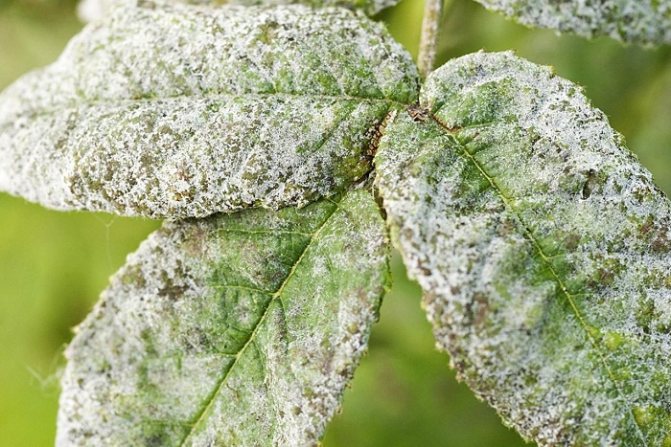

- Powdery mildew is a fungal disease. The plant lags behind in growth, loses its decorative effect. The fungus settles on the leaf surface and develops at high humidity and low temperatures. It can reproduce in dry weather as well. A white bloom appears on the leaves of the flower, which looks like a cobweb. Gradually covering the entire plant, which then dries up and dies. The sick flower is dug up and burned. Treat phlox with copper-containing preparations (Topaz, Bordeaux mixture).
- Spider mites often attack phlox. Spots appear on the leaves, which provoke dying off and falling off. If you do not take steps to get rid of, the plant will die. The upper parts of the flower are washed with warm water with the addition of laundry soap. This method will not destroy the tick, but will reduce its population. Special preparations (Borneo, Flumite, Agravertin) will perfectly cope with this task.
Regular examinations (at least once every two weeks) will help identify viruses and fungi. The sooner you do this, the better. As a preventive measure, ash is carried into the soil.
Phlox pests and diseases
The subulate phlox most often suffers from powdery mildew, spotting and attacks of caterpillars that eat away the stem. The signs of the first two diseases are sluggish leaves, specks and dots on the leaves. Sick leaves are cut off, and the entire planting of phloxes is treated with Bordeaux liquid. And when the caterpillars attack, the leaves of the plants are covered with a brown bloom and curl, in this case the phlox cannot be saved. It is recommended to spray plants for prophylaxis with Sumi-Alpha or Fury.
Phloxes of this species suffer from nematodes and filamentous worms, in order to prevent these unpleasant phenomena, phloxes are not planted in the area where strawberries grow. If you nevertheless planted phloxes and they get sick, then they are removed directly with a clod of earth, and then eliminated.
The use of subulate phlox in decorating the site


Phlox subulate will become a real decoration of rockery


The beautiful shrub has found wide application in garden design. It is often used to create beautiful alpine slides or vibrant lawns. Given the plant's low growth, it looks good as borders that adorn garden paths or grow between path tiles. Phlox is appropriate in flower beds and flowerpots, in single plantings, in combination with other flowers (sedum, snapdragon, bell) or cereals. Phlox subulate on the site - this is beauty for many years!
Choice of place and conditions of detention
Phloxes are unpretentious and peaceful flowers that have a weak root, so it is not worth planting them near plants with a highly developed root system, they will not be able to survive in such conditions.
Lighting and location
Temperature
The plant shows high resistance to low temperatures, it can be safely left without digging out for the winter. If during the flowering period low temperatures are observed at night, then the flowers will not lose their decorative effect and will delight their gardeners almost all summer.
Combination of phlox with other plants


Phlox in landscape design
Phlox compositions with primrose, poppy, edelweiss, dwarf iris and wormwood, aster are successful. This flower looks bright against the background of conifers with a clear shape: thuja, juniper, pine, dwarf spruce. Harmonious combinations of subulate phlox with other ground cover (stonecrop, rejuvenated). Annual plants are good in an ensemble with bells, snapdragons, cereals.
Advice. When choosing "neighbors" for phlox, take into account the flowering period of the plants. By intelligently combining flower cultures, you can create a colorful flower bed that will delight you from spring to autumn.
Phlox subulate and spread apart - what is the difference?
Many inexperienced summer residents often confuse two types of flowers - wide-spread and subulate. Many people think that these are the same phloxes, but this is a mistake. The difference in species is quite obvious - the height of the spreading varieties is up to 30-40 cm, they are not so diverse in colors, they are afraid of severe frosts and snowless winters, they are more demanding on the composition of the soil, the bushes are loose. Subulate phlox in nature can grow on poor soils and bloom well. Experienced summer residents found out that ground cover phlox bloom worse in very fertile soil.
Views
In this article, we will consider the most popular types and varieties of plants:
- Candy Strapes - very long flowering, many flowers, white with pink stripes. The plant is only about 10 centimeters long.
- Emerald Kushon Blue - the flowers are purple, they smell delicious. Blooms for a long time.
- Emerald Pink - very beautiful pink flowers.
- Scarlett Flame - up to 15 centimeters long, bright pink flowers.
Pyramidal
Some gardeners mistakenly consider these flowers to be a separate species, but this is not the case. Such flowers belong to phlox, but they look a little different. The flowers are collected as if in a "pyramid" and are somewhat reminiscent of an ear of corn. The stems have barely visible spots on the stems.
- Plants of these varieties grow tall - up to a meter or more.
- They look very nice and harmonious.
- Have dense foliage.
Delta
One of the most popular varieties. The usual height is 70-80 cm. The bush is wide, up to 40-50 cm. It usually blooms in mid-summer. The flowers are white-pink, with a bright eye in the center.
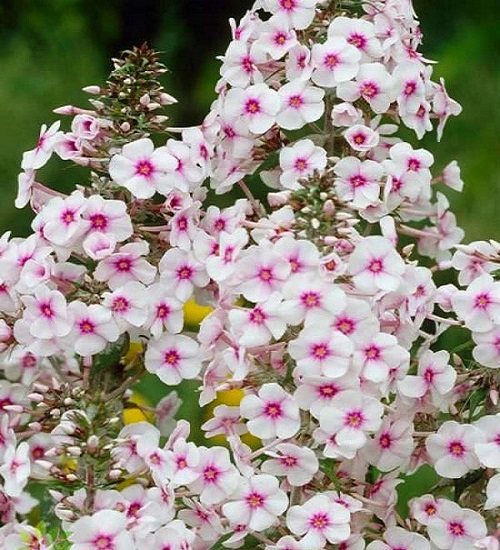

Natasha
Quite a capricious variety of spotted phlox. Such phlox do not grow very quickly, moreover, they do not tolerate the bright sun. The bush can grow up to 70 cm, in width - up to 50 cm. It blooms in July-August.
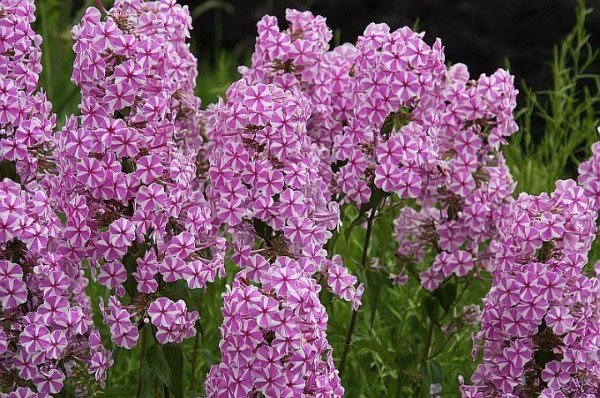

Shneelavin (Snow avalanche)
With good care, the bush can grow up to 70-80 cm. "Snow avalanche" blooms in July, with white flowers. They can be up to 3 cm in diameter.
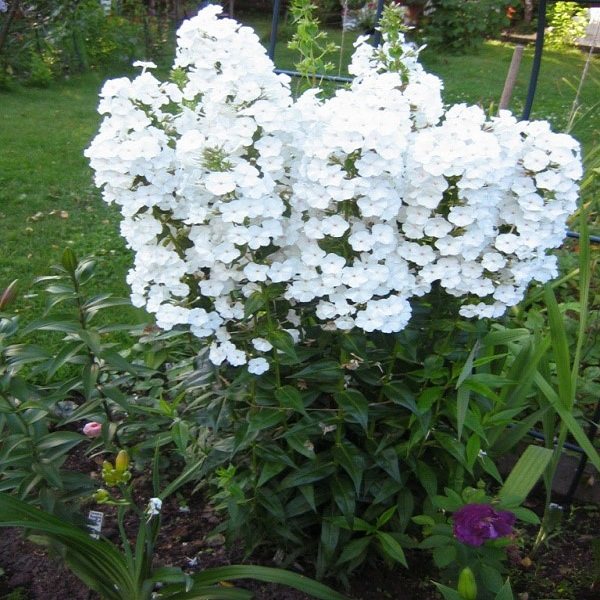

Landing features
To ensure maximum flowering, subulate phlox should be planted in well-lit, slightly elevated areas, on dry, loose, aerobic sandy or loamy soils with neutral acidity.... It can grow in light shade, but bloom will be noticeably worse. But the culture does not tolerate the close location of groundwater, swampiness, stagnation of melt water and moisture at all.
Clayy, water-absorbing soils are loosened with sand and peat (bucket per 1 m2), making them crumbly. Too acidic soils are deoxidized with fluff (1-2 cups per 1 m2) or dolomite flour (200-400 g per 1 m2).


Subulate phlox can grow in light partial shade of large trees
The selected area is first dug up, carefully choosing the rhizomes of perennial weeds (loach, wheatgrass, etc.), while applying in very moderate quantities in order to prevent excessive growth of the green mass (for each m2):
- humus or compost (3-4 kg);
- crushed wood ash (50-60 g).
Landing technology:
- The holes are not dug too deep (5–15 cm), since the root system of the phlox is rather superficial.
- Leave at least 25–30 cm between individual specimens, as the plants grow rather quickly.
- Drainage from expanded clay or pebbles (3-4 cm) must be poured at the bottom.
- The bushes are laid out, carefully straightening the roots.
- Then sprinkle with soil mixture and compact.
- Water and mulch with humus, peat, etc.
Phlox subulate reproduces in several ways:
- Seeds. Least rarely used method... Seed material is sown before winter in bowls with loose soil mixture, then put in a cool place for stratification (you can do without it). In the spring, at the stage of 4–5 true leaves, the seedlings are planted in a permanent place.
- Cuttings. Cuttings are harvested in spring and summer, any shoot, even an accidentally broken off, will do. The cut material is stuck into a moistened substrate of sand and peat, covered with jars or cut plastic bottles to create a greenhouse effect. After 1-2 weeks, the cuttings take root, the shelter can be removed. In the fall or spring of next year, determine the flower bed.
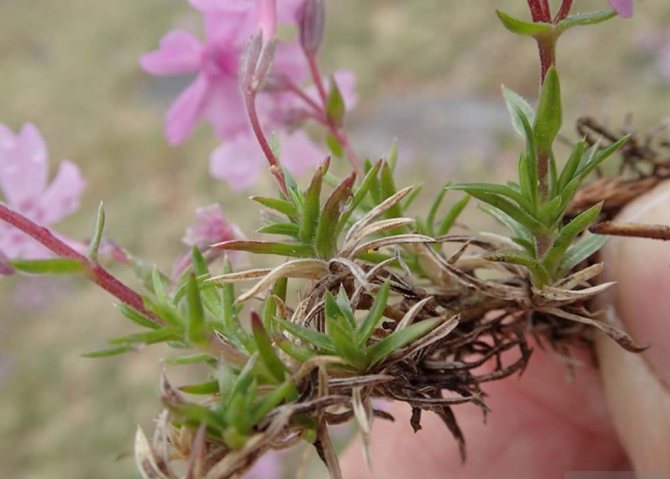

Phlox cuttings root very quickly
- By dividing the bush. Large adult bushes are dug up and divided into parts, each of which should have its own root system... Then they are planted in the right places.
- Rooting shoots. The shoot is bent down, pinned to the ground, sprinkled with soil in this place and watered. After rooting, they are separated from the mother plant.
Very often, it is not required to specially lay phlox shoots on the ground, because they themselves easily take root, after all, the lashes spread and crawl in different directions. I take such planting material in the fall, while the small bushes have not grown too much.
Video: planting and reproduction of subulate phlox
Conditions for growing flowers
Phlox subulate is a very unpretentious flower that can adapt to any conditions. It can grow both in southern latitudes and in regions with a harsh climate. Not picky about the composition of the soil.
Attention! On the territory of Russia, monks were originally engaged in planting and growing phloxes. These flowers adorned the monastery courtyards.
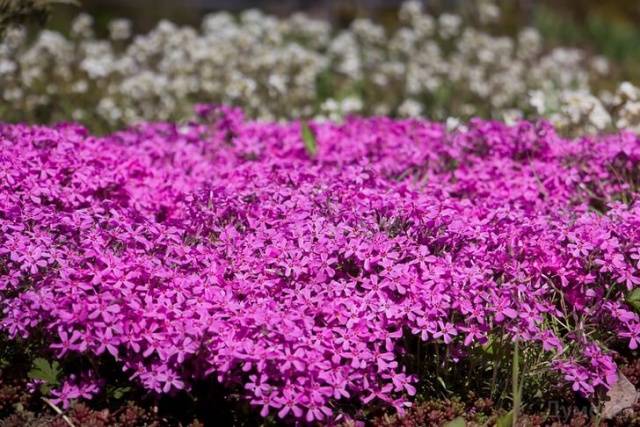

However, in order for phlox to please with their long flowering, it is advisable to create conditions for them that are as close as possible to natural ones. Considering that in its homeland this flower grows on sandy or rocky hills, rocky slopes, it means that the soil should not be too fertile.
Before planting subulate phlox, it is important to know that it can grow in partial shade, but a riot of colors and colors can be seen only if you plant a flower in a place sufficiently illuminated by the sun's rays. Phlox is a light-loving plant.
Thanks to their wild-growing ancestors, flowers can easily endure a short period of drought. But too long dry period immediately affects the appearance of the plant - the foliage becomes pale, faded and unattractive.
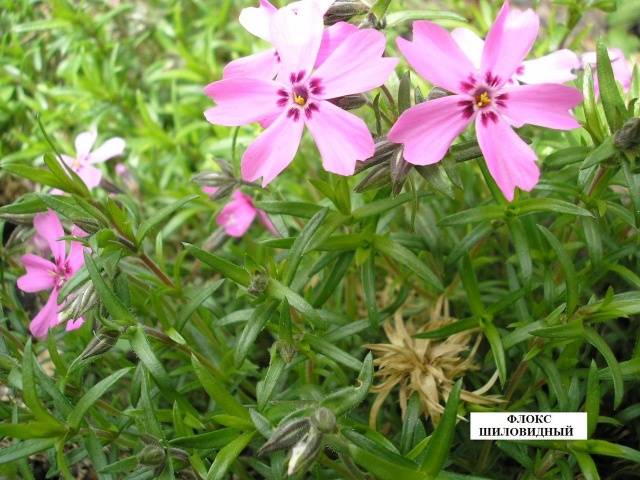

When choosing a site for planting subulate phlox, it is important to consider that moisture stagnation has a detrimental effect on plants. Therefore, areas with a groundwater level close to the surface, as well as those on which melt and rainwater stagnate in spring, are unsuitable for growing flowers.
In places with excessive moisture, they grow very slowly, the root system weakens, the whole plant looks sick and weak. The effect of a green and floral carpet is very difficult to achieve. Most often, phloxes inevitably die in such areas. To correct this deficiency, when preparing the soil for planting, you can add sand to the soil and raise the flower garden by 25-30 cm.
Attention! Among the variety of varieties, there are phlox, which gardeners call "chameleons" - flowers can change colors depending on the weather.
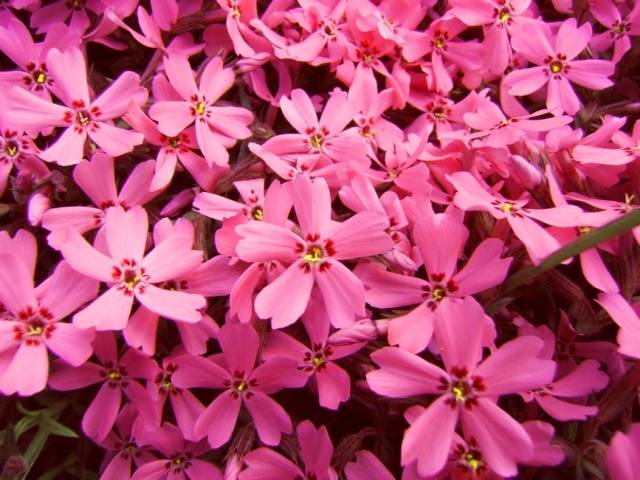

When planting perennial styloid phlox, plants that were grown in the selected area earlier are of great importance. The best precursors for flowers will be plants that are resistant to nematodes: tagetes, calendula, marigolds, kareopsis, perennial lawn grasses, and others.
In no case should phlox be planted in areas where strawberries, strawberries, garlic and other crops that do not have resistance to nematodes used to grow.
It is advisable to set aside for planting the styloid phlox those areas on which there is the most snow in winter. In this case, you will not need to worry about hiding flowers for the winter. A snow cover will sufficiently cover your plants and save them from freezing.


This type of phlox grows well on poor, loose and dry soils. When flowers are grown on fertile, oily soils, a high growth of green mass is observed, however, flowering is very poor, and the flowers become small and pale.
The acidity of the soil should be closer to neutral. Acidic soils need to be limed, alkaline soils need to be deacidified.
Important! When combining phlox with other plants, it is important to choose the right "neighbors" for the flower garden, so that tall plants do not block the sunlight, which is so necessary for flowers for active flowering.
Choosing a place and soil for planting
The subulate phlox has no special requirements for growing conditions. He is flexible and easily put up with difficulties. But he will show himself as much as possible in open and sunny rocky or sandy areas. Hilly areas and small slopes are preferable. The main thing is that moisture should not stagnate in the landing sites. Otherwise, phlox grows poorly, the sod will not be dense and may wither away.
Soils for phlox subulate should be loose and poor with neutral acidity. Acidic soils are lime, the rate of lime consumption is 150-200 g / sq. m. River sand is added to clay soils.
Danger of disease
Subulate phloxes can die from disease and pest attacks. The main disease is powdery mildew, which is a fungal infection. Plants stop developing and blooming, leaves become covered with bloom and wither. In this case, the bushes must be removed and the top soil layer removed. Neighboring flowers should be treated with antifungal drugs - "Topaz", a suspension of foundationol, copper sulfate, soda ash.
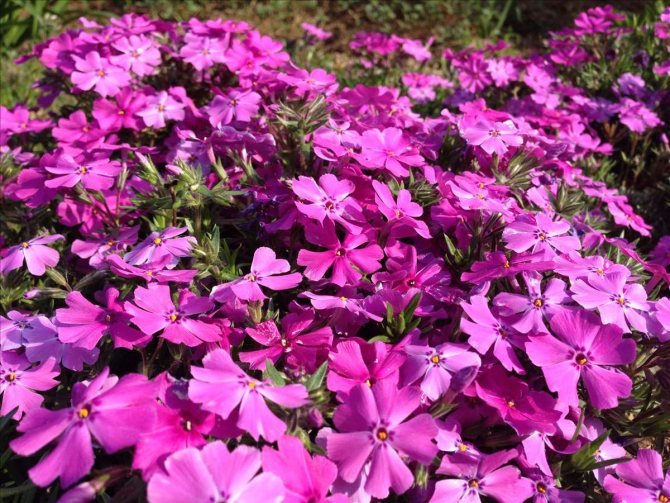

Amazing shades of subulate phlox
Another danger is spider mites and caterpillars. When a tick appears on the leaves, strange spots form, spoiling the appearance.Caterpillars cause brownish tinge on foliage. The leaves begin to curl. For pest control, it is necessary to use special chemical compositions. After removing diseased plants at the place of their growth, it is not recommended to plant phloxes for 4-5 years.
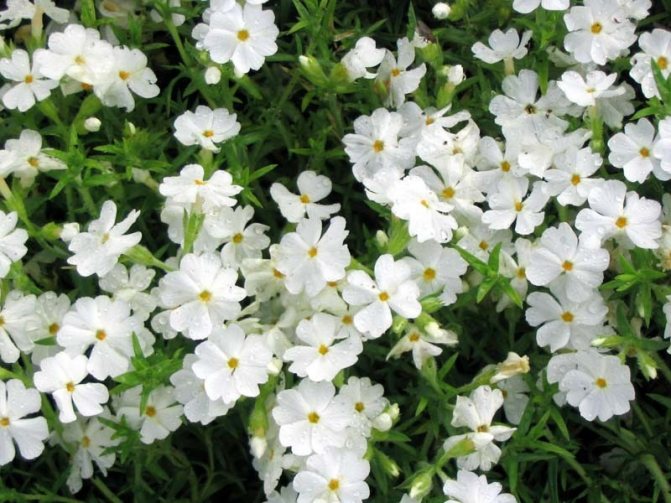

White phlox after dew
Description and features
Phloxes from the same species may vary as they are influenced by climatic conditions. For example, alpine ones grow from 5 to 25 cm, bryophytes. Their trunks are branching, covered with evergreen foliage. In a favorable climate, the stem of the phlox becomes straight, the height is from 30 cm to 1.8 m.The leaves are opposite, the shape is elongated-ovate or lanceolate-oval. The diameter of the buds is 25-40 mm, tubular-funnel-shaped.


Most species are perennials, but Drummond's phlox and varieties are annuals.
Plant features
The issue of planting and caring for subulate phlox cannot but interest true lovers of decorative floriculture. What is this flower?
Interesting! The subulate phlox is a perennial, beautifully flowering plant belonging to the Sinyukhov family. It has a fairly strong stem of an erect or creeping type, lanceolate leaves in the form of a slightly elongated oval with a pointed edge and an even edge.
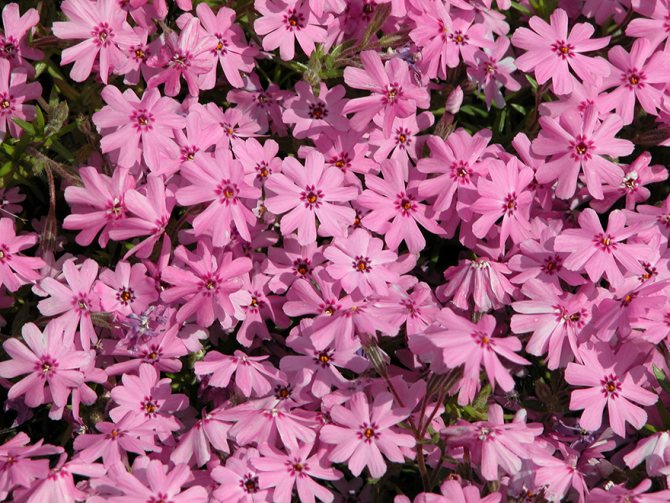

Beautiful subulate perennial plants - phlox
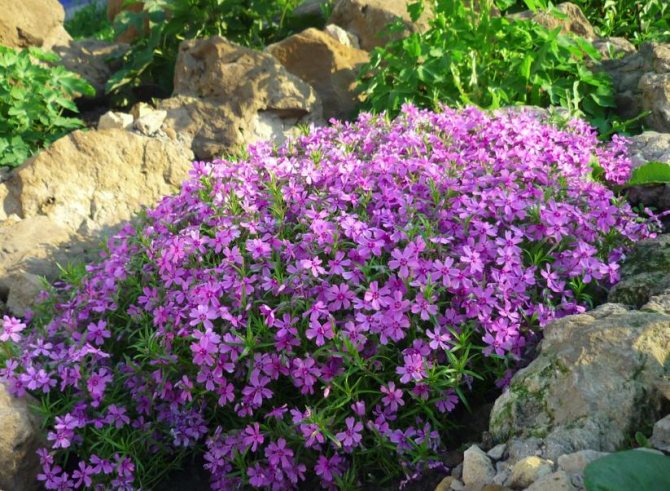

Perennial phlox grow among stones
This type of phlox is distinguished by varietal diversity. You can choose low plants with a height of no more than 25 cm. There is another extreme - giants with a height of 1.1-1.3 m. Taking this into account, you can make up a variety of landscape compositions from them - in the form of a bright carpet or a large-scale group of flowers.
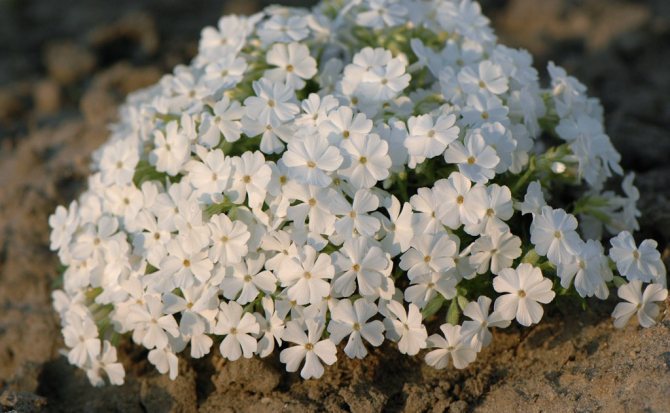

Snow-white subulate phlox
In recent years, selective, two-color varieties (for example, "Flame of the Eye") have gained popularity. The photo illustrates the beauty of blooming phlox.
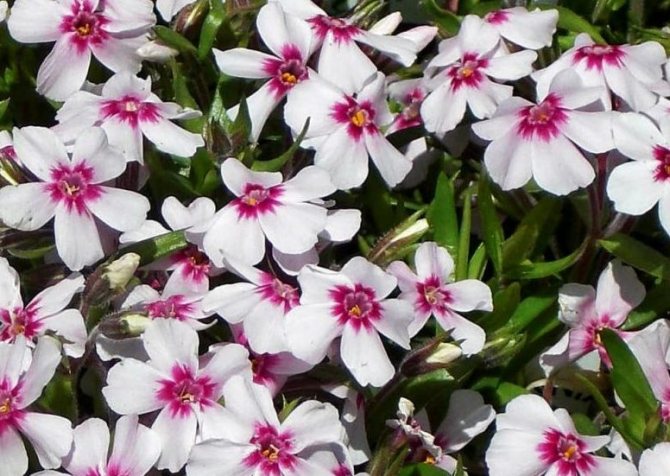

Two-color perennial phlox
Possible breeding methods
Subulate phlox can be propagated using seeds, roots or cuttings. The procedure can be performed at any time of the year. To do this, you need to separate the root from the plant or cut off the stem, put it in warm water for a week. As soon as dense roots appear, the seedlings can be planted in the ground, abundantly watered with water.
Important! To make growth more efficient, you can add Kornevin to the water before that. The process of propagation by cuttings and stems is identical.
By seeds, reproduction occurs as follows: the most beautiful flower is taken and seeds are taken out of it. They are placed in water. As soon as the first roots appear from them, they can be transplanted into open ground.
There is another breeding method. However, it is the most difficult and rarely when the summer resident manages to complete it. This is division by leaves. To do this, the leaves, along with the stem, are placed in the soil at an angle and covered with foil. As soon as the roots appear and the plant does not stagger, everything is transferred to the ground.
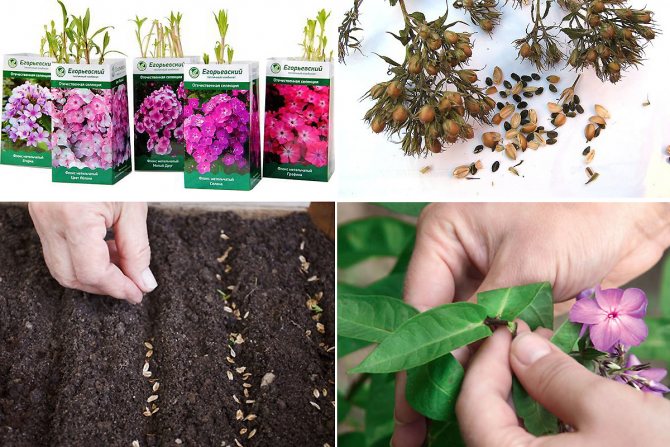

Reproduction
How to care for flowers
After planting subulate perennial phlox, care consists in carrying out the usual events for each grower:
- watering as needed;
- feeding according to the scheme;
- regular weeding.
Water the flowers as needed. Look at the condition of the soil. As soon as it gets dry, at a depth of 2-3 cm - moisten the flower garden. Abundant watering is not required for plants, since fungal diseases develop rapidly with waterlogging.
Phlox can be fed three times during the season. But keep in mind that with an excess of fertilizer in the soil, the plants practically stop blooming, directing all their forces to the growth of the green mass.
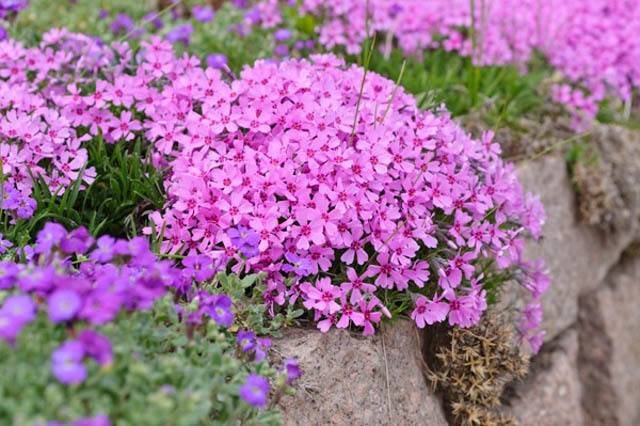

So you need to fertilize the flowers only if the land is really very scarce.The recommended feeding scheme is as follows:
- immediately before the beginning of flowering and after the last petals have flown around, you can feed the subulate phlox with nitrogen-potassium fertilizer;
- in mid-July - early August, apply a complex mineral fertilizer to the soil.
Advice! Immediately after flowering, you need to cut off the flowering shoots of the styloid phlox by 1/3. This procedure will allow the plant to direct all its forces to the formation and growth of young shoots, which will ensure more lush flowering next year.
If your plants look pale, grow poorly, and bloom poorly, you can fertilize phlox with an ash solution. To prepare this mixture, you need to pour 300-400 g of wood ash with water in an amount of 2 liters, put on fire and boil for 10 minutes. Remove from heat, cool, strain and dilute the solution in a bucket of water.
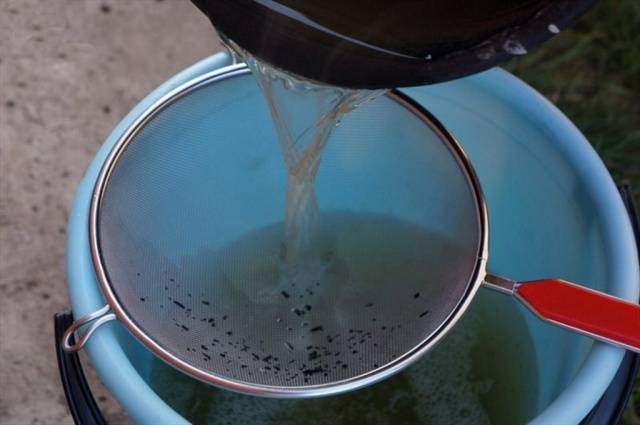

This mixture will not only enrich the land, but will also help as a prophylaxis against insect pests.
You need to weed the flower garden as often as possible, preventing the weeds from growing.
With the right choice of a suitable place, proper care after planting perennial subulate phloxes, emerald green carpets will retain their decorative effect for 5-6 years.
Creeping varieties have high frost resistance. However, in warm winters with heavy snowfalls, the stems and foliage can grow out in places. By spring, the plants lose their decorative attractive appearance. But subject to the rules of agricultural technology and care, moss carnations quickly recover and again delight the eye with a green carpet and abundant flowering.
Important! In areas with a harsh climate, subulate phlox can be covered with spruce branches.
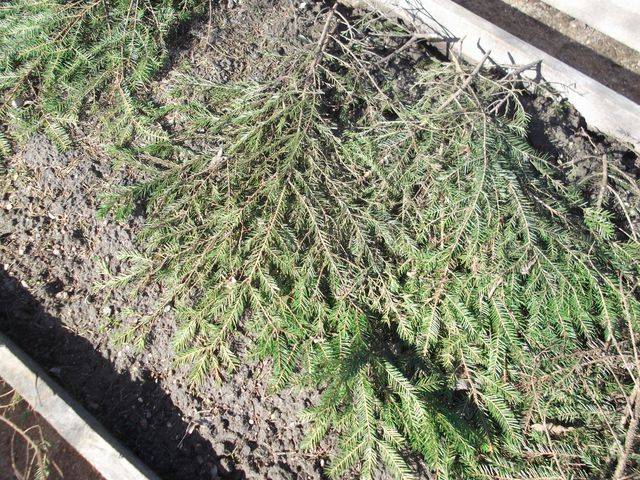

Flowers need to be rejuvenated every 5-6 years. The immunity of old plants is significantly reduced, they are increasingly sick. The root system grows woody over time, the previously lush and thick carpet becomes faded, bare areas appear, gradually the bushes lose their brightness and decorative effect. Age also affects flowering - the flowers gradually become smaller, lose their brightness. Over time, varietal characteristics can be irretrievably lost.
Description of the flower
The homeland of the styloid phlox is North America, the states of Virginia and Korolina. In the United States, you can find whole plantations of fields and meadows with different types of phlox. They are unpretentious to the soil, grow on the slopes of mountains and hills, on the edge of the forest, along the banks of rivers.
In 1737, the biologist and researcher Karl Linnaeus, having carefully studied the styloid phlox, first characterized it. In English the word "fluffy" and in German - "flock" is translated as "fluffy". Lush inflorescences of subulate phlox are also called "moss carnations". The Greeks compared the flower to a "flame", because some varieties were similar to bright lights.
Some scientists argue that this plant got to Asia in the 19th century thanks to migratory birds. In Russia, some species of wild phlox can be found on the banks of the Yenisei and Lena, in Transbaikalia, on the slopes of the shores of the Bering Strait. But it is the subulate variety that is found only in gardens, specially grown under certain conditions.
A subulate phlox is a low-growing creeping plant with a height of 15 - 17 cm, which flower growers like because even after frost its leaves resembling an awl remain green. No wonder phlox is called an evergreen winter-hardy perennial. The diameter of the subulate phlox flowers reaches 25 mm.


The first varieties of phlox subulate were obtained by English breeders in 1745 - 1746, and they were grown in the gardens of aristocrats. For the first time, a book about an unusual double flower was written in 1948 by Maria Pavlovna Bedinghaus: "Perennial subulate phlox: planting and care." It has become a guide for several generations of gardeners.
In Russia, on garden plots, you can find a variety of subulate phloxes in color. The flower is purple, lilac, white, pink, blue, purple.Our country can only grow complex hybrids of the styloid phlox. But this species is a hybrid, and its further reproduction is impossible. Our floriculture companies buy these seeds in the USA, France, Holland, England, Germany and Japan.
Brief description of the species
Phlox subulate refers to perennial, carpet, creeping plants. In its historical homeland, in the USA, it is called a moss carnation. The distribution area of flowers is wide enough. If half a century ago phlox grew mainly in the wild nature of North America, now these unpretentious and beautiful flowers are grown almost all over the world.
When growing subulate phlox, it should be borne in mind that in the wild they grow mainly on poor, rocky soils, dry sandy hills, rocky slopes and in the shade of shrubs.
The maximum height of flowers is no more than 15-17 cm. The subulate phlox grows very quickly, forming emerald green rugs. Even before winter, these plants go away, keeping the green brightness of the foliage.


Attention! In Greek, phlox means flame.
Basal stems of phlox subulate recumbent, covered with frequent nodes with short internodes. The leaves are short (up to 2 cm), narrow, sharp and tough. In the process of growth, the plant forms a large number of stems, which end in bright inflorescences. Each stem can have 2-7 flowers at the same time. Single peduncles are extremely rare.
The flowers of the subulate phlox are small, from 2 to 4 cm in diameter, white, bright pink, lilac, blue, purple shades with different tones. The flowering period of subulate phlox is short, only 3-4 weeks. The plant gains color in the second half of May. Violent flowering continues until mid-June.


Phlox bloom so densely and densely that greenery is practically invisible under the flower carpet. Phlox subulate can bloom and repeatedly, in the second half of August - early September. But the secondary flowering is not so abundant and bright.
There are a lot of varieties of phlox styloid, but they are all the result of selection. These beautiful, inimitable flowers will be a worthy decoration of any personal plot. Very often, these plants are used to compose landscape design compositions, decorating alpine slides, rocky gardens, rockeries, mixborders.
Comment! Phlox have been cultivated as garden flowers since the second half of the 18th century.
Flowers reproduce mainly in a vegetative way. You can plant subulate phlox with seeds once, and subsequently the plant grows very quickly. Some varieties of phlox practically do not form full-fledged seeds, and therefore these flowers are often sold in pots.


The harsh climate is not a significant obstacle to the cultivation of subulate phlox, as they easily tolerate severe frosts. These plants also do not have special requirements for the composition of the soil.
The only thing that phloxes don't like is prolonged drought. These plants have a superficial root system. Short roots are not able to "extract" moisture from deeper soil layers.
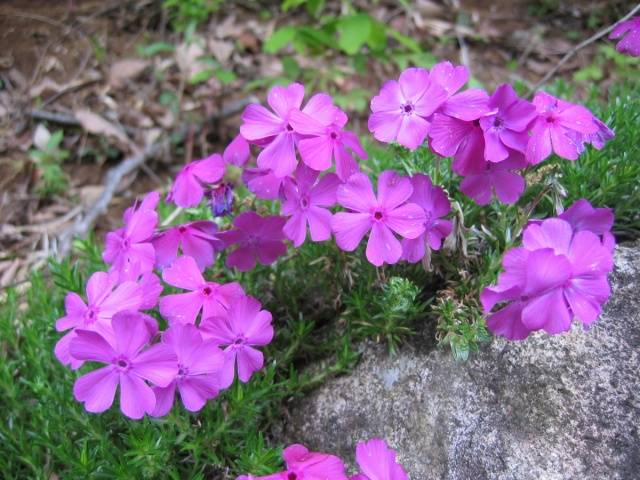

Why are these flowers so popular? First, after abundant flowering, the plants retain the bright green color of the foliage almost until the very frost. Secondly, planting subulate phlox and leaving is not particularly difficult. A novice florist can also cope with this task, and a blooming carpet in your flower bed will be the reward for your efforts.

